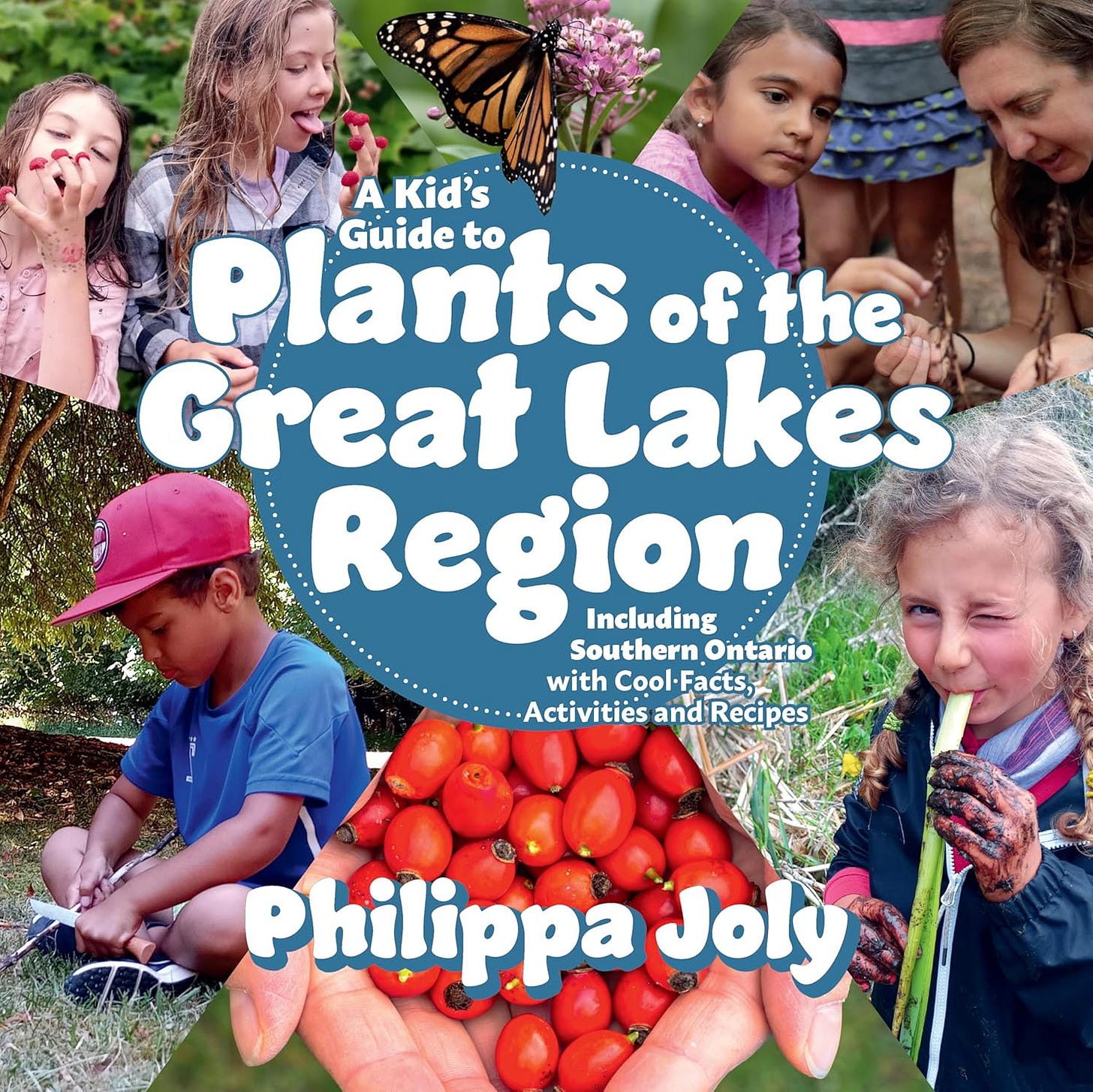A Kid’s Guide to Plants of the Great Lakes Region by Phillipa Joly
Reviewed by Lisa Timpf
The field guides I used as a child were informative in a matter-of-fact, and often dry, way. A Kid’s Guide to Plants of the Great Lakes Region by Philippa Joly offers a broader, more hands-on approach.
Joly’s book is billed as “a middle-grade-friendly introduction” to the flora of the Great Lakes Region, as well as Southern Ontario. As advertised on the cover, the book also offers “cool facts, activities, and recipes.” A Kid’s Guide to Plants of the Great Lakes Region is attractively laid out with plenty of photos, call-outs with information, subheadings, and hand-drawn images.
In line with being middle-grade-friendly (“middle grade” includes ages 8 to 12, according to online sources), the book includes observations made by kids, such as 12-year-old Sarita’s comment that thistle “tastes like celery crossed with cucumber.” The book includes lots of photos of children engaging in plant-related activities.
With the target audience in mind, there’s also a “Safety First” section that notes “it’s very important that anyone using this book and eating wild plants be sure of what they’re eating,” advising “before you eat a plant in the wild, ask a knowledgeable adult if it’s okay to do so.”
Though the book is middle-grade friendly, there’s still information of value for older readers. I picked up a lot of interesting facts on my read-through, including the medicinal and food uses of a number of the plants in my backyard.
The book begins with chapters on “Indigenous Peoples of the Great Lakes Region,” “Regions and Plants Covered by This Book,” “Plant Names and Language,” “The Dos and Don’ts of Wildcrafting Plants,” “Understanding Plant Families,” “Poisonous Plants,” and “Invasive Plants.”
Next come the fifty detailed “plant profiles.” The plants are organized into chapters by the season in which they can be “harvested” for use, which makes for easy access to season-relevant information. For example, Bee Balm and Oxeye Daisy are included in the summer section, while Wild Grape appears in the autumn section. Within the chapters, the plants are organized alphabetically by their common names.
The individual plant profiles vary in length, and include the common and Latin names, a description of the plant in question, interesting facts, and harvesting tips. Each plant profile includes a symbol indicating whether the plant is edible, is not edible but non-fatal if eaten, is rare (and should not be picked), has medicinal uses, or is poisonous and should not be touched. There is also a symbol for activities which require an adult’s help. For many of the plants, there is a “try this” section with an activity, a craft, or a recipe.
The book includes recipes for a wild root roast, campfire tea made from fir tips, and a raspberry smoothie, among others. Among the activities are instructions for making artist’s charcoal from wild grapevine, making buckthorn ink, or constructing a “nature clock” or sundial using a stick and some stones. Suggestions for scavenger hunts in different seasons, a tree quiz, and a variety of activities that encourage close observation of the natural world are also offered.
Near the end of the book, there’s a glossary of terms including words like “alkaloid,” “ephemeral,” and “palmate.” Words included in the glossary are highlighted in the text, so readers know that a definition is available if they flip to the back. Selected references are provided, and an index makes it easy to look up key information.
Throughout the book, readers are encouraged to treat the environment with respect, to harvest with consideration for the plant’s health, and to leave enough of the plant and its fruits or seeds to accommodate the needs of wild creatures. These creatures use it as a food source.
If you live in the Great Lakes Region or Southern Ontario and are looking for ways to get the middle-grade-aged children in your life curious about, and engaged with, the outdoors, then A Kid’s Guide to Plants of the Great Lakes Region is worth a look.
About the Author
Philippa Joly is a clinical and community herbalist, paramedic and outdoor educator. She runs an outdoor school for kids and leads workshops on herbal medicine, plant identification, ethical wildcrafting, herbal first aid, local healing plants and anticolonial approaches to wellness. Her first book, A Kid's Guide to Plants of the Pacific Northwest, won a Silver Medal in the Moonbeam Children's Book Awards (2023) and was long-listed for the AAAS/Subaru SB&F Prize for Excellence in Science Books (2024). Joly lives on Denman Island, BC, with her plant-savvy daughter, Breah.
Book Details
Publisher : Harbour Publishing (Aug. 5 2025)
Language : English
Paperback : 224 pages
ISBN-10 : 1998526100
ISBN-13 : 978-1998526109




